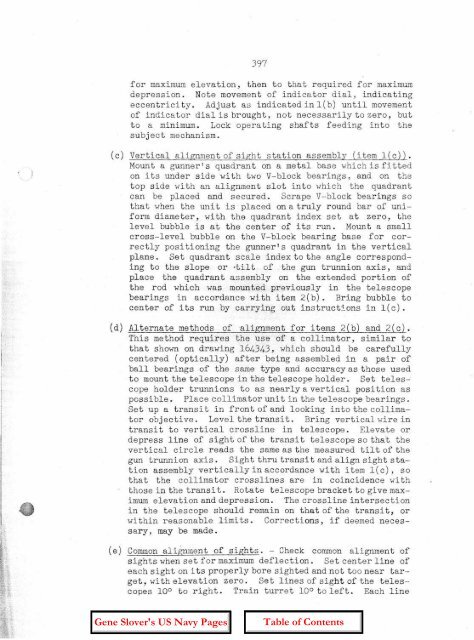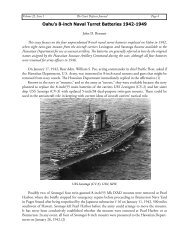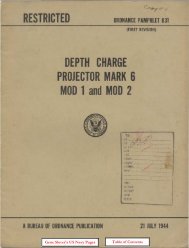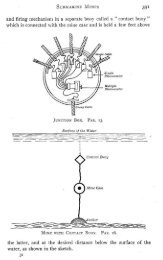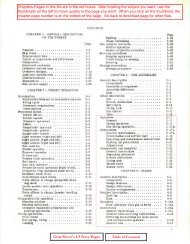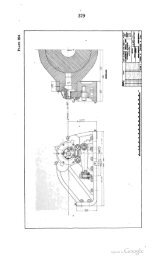OP-755 Part 2 Pages 197-401 - Personal Page of GENE SLOVER
OP-755 Part 2 Pages 197-401 - Personal Page of GENE SLOVER
OP-755 Part 2 Pages 197-401 - Personal Page of GENE SLOVER
You also want an ePaper? Increase the reach of your titles
YUMPU automatically turns print PDFs into web optimized ePapers that Google loves.
397<br />
for maximumelevation, then to that required for maximum<br />
depression. Note movement <strong>of</strong> indicator dial, indicating<br />
eccentricity. Adjust as indicated in l(b) until movement<br />
<strong>of</strong> indicator dial is brought, not necessarily to zero, but<br />
to a minimum. Lock operating shafts feeding into the<br />
subject mechanism.<br />
(c) Vertical alignment <strong>of</strong> sight station assembly (item l(c)).<br />
Mount a gunner's quadrant on a metal base which is fitted<br />
on its under side with two V-block bearings, and on the<br />
top side with an alignment slot into which the quadrant<br />
can be placed and secured. Scrape V-block bearings so<br />
that when the unit is placed on a truly round bar <strong>of</strong> uniform<br />
diameter, with the quadrant index set at zero, the<br />
level bubble is at the center <strong>of</strong> its run. MoUnt a small<br />
cross-level bubble on the V-block bearing base for correctly<br />
positioning the gunner's quadrant in the vertical<br />
plane. Set quadrant scale index to the angle corresponding<br />
to the slope or ·til t <strong>of</strong> the gun trunnion axis, and<br />
place the quadrant assembly on the extended portion <strong>of</strong><br />
the rod which was mounted previously in the telescope<br />
bearings in accordance with item 2(b). Bring bubble to<br />
center <strong>of</strong> its run by carrying out instructions in l(c).<br />
(d) Alternate methods <strong>of</strong> alignment for items 2(b) and 2( c).<br />
This method requires the use <strong>of</strong> a collimator, similar to<br />
that shown on drawing 164343, which should be carefully<br />
centered (optically) after being assembled in a pair <strong>of</strong><br />
ball bearings <strong>of</strong> the same type and accuracy as those used<br />
to mount the telescope in the telescope holder. Set teles-"<br />
cope holder trunnions to as nearly a vertical position as<br />
possible. Place collimator unit in the telescope bearings.<br />
Set up a transit in front <strong>of</strong> and looking into the collimator<br />
obj ecti v e , Level the transi t. Bring vertical wire in<br />
transi t to vertical crossline in telescope. Elevate or<br />
depress line <strong>of</strong> sight <strong>of</strong> the transit telescope so that the<br />
vertical circle reads the same as the measured tilt <strong>of</strong> the<br />
gun trunnion axis. Sight thru transi t and align sight station<br />
assembly vertically in accordance with item l( c), so<br />
that the collimator crosslines are .m coincidence with<br />
those in the transi t. Rotate telescope bracket to give maximum<br />
eievation and depression. The crossline intersection<br />
in the telescope should remain on that <strong>of</strong> the transit, or<br />
within reasonable limits. Corrections, if deemed necessary,<br />
may be made.<br />
(e) Commonali@ment <strong>of</strong> sights. - Check common alignment <strong>of</strong><br />
sights when set for maximumdeflection. Set center line <strong>of</strong><br />
each sight on its properly bore sighted and not too near target,<br />
with elevation zero. Set lines <strong>of</strong> sight <strong>of</strong> the telescopes<br />
10 0 to right. Train turret 10 0 to left. Each line


